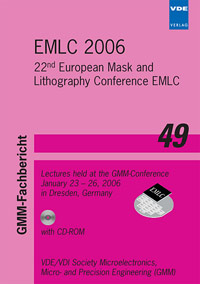Manufacturability and printability of AAPSM with transparent etch stop layer
Conference: EMLC 2006 - 22nd European Mask and Lithography Conference
01/23/2006 - 01/26/2006 at Dresden, Germany
Proceedings: EMLC 2006
Pages: 6Language: englishTyp: PDF
Personal VDE Members are entitled to a 10% discount on this title
Authors:
Cangemi, Michael (Photronics - assigned at IMEC, Belgium)
Philipsen, Vicky; Ruyter, Rudi De; Leunissen, Leonardus (IMEC, Kapeldreef 75, 3001 Leuven, Belgium)
Morgana, Nicolo; Sixt, Pierre (Photronics, France)
Cangemi, Marc; Cottle, Rand; Kasprowicz, Bryan (Photronics, USA)
Abstract:
Phase-shift mask (PSM) technology in combination with 193nm illumination remains a viable option for high contrast imaging towards 45nm half-pitch applications. The advent of hyper NA (immersion) lithography increases the imaging sensitivity towards the photomask properties, such as mask-induced polarization. In addition, the use of PSM technology implies taking into account the inherent photomask topography effects for a balanced through pitch imaging. A good quartz etch depth control of +/-1deg through pitch is required for optimized wafer imaging. Therefore, a new PSM material stack was proposed based on a transparent etch stop layer (TESL) in order to meet the stringent phase depth requirements beyond 65nm half-pitch. This extra layer allows over-etching of the quartz, resulting in a good etch depth linearity and uniformity. This study examines the manufacturability of TESL-based masks in terms of depth uniformity. We examine the effect of an improved quartz etch depth linearity on the through-pitch process windows for a TESL-based alternating aperture (AA)PSM. Moreover, due to the different stack of photomask material compared to a classical photomask blank, the impact on printability is investigated by simulations, AIMS and wafer imaging. The image imbalance compensation by trench biasing needs to be optimized for through-pitch process windows. The actual depth and line width of the structures is systematically probed within the photomask field. Based on photomask metrology data, rigorous electro-magnetic field simulations are compared to wafer prints, obtained on an ASML XT1250Di ArF immersion scanner working with a 0.85NA projection lens. Furthermore, feature sizes on the order of the lithography wavelength induce photomask polarization effects in the imaging path. The degree of polarization is compared to the polarization behavior of a conventional PSM. In summary, this study assesses the capability of TESL PSM towards the 65nm node through-pitch imaging.


